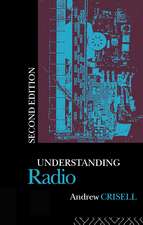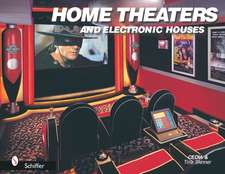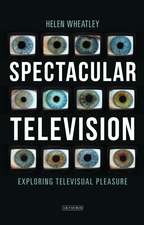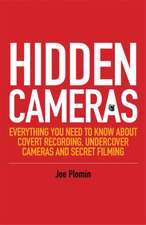The Magic Window: American Television ,1939-1953
Autor Jim Von Schillingen Limba Engleză Paperback – 4 noi 2002
Preț: 260.13 lei
Preț vechi: 349.16 lei
-25% Nou
Puncte Express: 390
Preț estimativ în valută:
49.77€ • 52.11$ • 41.19£
49.77€ • 52.11$ • 41.19£
Carte tipărită la comandă
Livrare economică 07-21 aprilie
Preluare comenzi: 021 569.72.76
Specificații
ISBN-13: 9780789015068
ISBN-10: 0789015064
Pagini: 246
Dimensiuni: 156 x 216 x 18 mm
Greutate: 0.46 kg
Ediția:New.
Editura: Taylor & Francis
Colecția Routledge
Locul publicării:Oxford, United Kingdom
ISBN-10: 0789015064
Pagini: 246
Dimensiuni: 156 x 216 x 18 mm
Greutate: 0.46 kg
Ediția:New.
Editura: Taylor & Francis
Colecția Routledge
Locul publicării:Oxford, United Kingdom
Cuprins
- Preface
- Chapter 1. The Beginning of Everything
- Television's Debut
- The Jenkins Television System
- RCA Television
- Television's First Season
- Test-Marketing in Newburgh
- The FCC's First Report on TV
- The Amber Light
- Hearings in Washington
- Chapter 2. A Torch of Hope
- The Future Appears in Newburgh
- The War in Europe
- The 1940 Republican Convention
- A Disappointing Fall
- Debating TV's Future in 1941
- Chapter 3. In a Troubled World
- The 1941 FCC Hearings
- The Beginning of Commercial TV
- The Summer of 1941
- The Buildup to War
- Wartime Television
- Schenectady's WRGB
- Plans for Postwar TV
- Television As a War Weapon
- The Studios Reopen
- TV's First Censored Program
- Chapter 4. The Winds of Postwar
- The Homefront TV War
- The 1944 Conventions
- TV Programs Blossom Again
- Docket No. 6651
- TV and the End of the War
- Chapter 5. Turning the Corner
- The Camera with the Eyes of a Cat
- TV Begins in Washington
- The Louis-Conn Fight
- Hour Glass
- The New Postwar Sets
- The Bikini Bomb Explosion
- Surveying the TV Viewer
- The Emerging Genres
- Drama in Washington
- The First Color Telecasts
- Integration on TV
- The Second Wave of TV Stations
- The “Split” TV Audience
- Television and Women
- Middlebrow Television
- Chapter 6. From Boom to Berle
- The 1947 World Series
- Puppet Playhouse
- The Expanding Network
- The “Original Amateur” Network
- “Miss Television of 1948”
- “Mr. Television”
- The 1948 Conventions
- The Cold War on Television
- CBS's Revival
- The Big Freeze
- The 1948 Election
- Selling Sugar and Tobacco
- Radio Takes Notice
- Chapter 7. Conflicts in the Air
- Kukla, Fran and Ollie
- The Cultural Backlash Begins
- Censoring TV's Contents
- The “Golden Hope” and The Goldbergs
- The Admiral Broadway Revue
- The Berle Phenomenon
- A Midseason Slump
- Wrestling and Roller Derby
- The 1949 World Series
- The Chicago School of Television
- Cavalcade of Stars
- Hopalong Cassidy
- The New Bomb and the “Red Scare”
- Faye Emerson
- TV's Effects on Children
- Chapter 8. Comics and Communists
- Your Show of Shows
- The “Bandit Raid” on Korea
- Red Channels
- The Invasion of Comics
- Jack Benny and Fred Allen
- Groucho Marx and Martin and Lewis
- Jackie Gleason and the Cavalcade of Stars
- Truman and MacArthur
- Expanding the Daily Schedule
- Chapter 9. Linking Coast to Coast
- Color TV Begins
- The Crime Commission Hearings
- Amos 'n' Andy
- Hollywood and the Coast-to-Coast Link
- The Birth of I Love Lucy
- The “Hollywood Boom” Begins
- The Today Show
- New Hampshire and “Ike”
- The Freeze Is Lifted
- Lucy Takes Over
- The 1952 Conventions
- Congress and the Code
- The FCC and Blacklisting
- Dragnet
- Live Drama from New York
- Chapter 10. Liking Ike and Loving Lucy
- The Checkers Speech
- Lucy is Pregnant
- Ozzie and Harriet
- See It Now
- The Birth and the Inauguration
- The ABC-Paramount Merger
- The End of the Du Mont Network
- The End of the Beginning
- Notes
- Index
- Reference Notes Included
Descriere
This fascinating book tells the story of how television became popular in the United States following the medium's debut at the 1939 New York World's Fair. You'll learn about the people, events, and performances that were televised—or influenced what was being televised—from 1939 to 1953. In addition to the entertainment and cultural aspects of this newborn medium, The Magic Window also explores the business, politics, and technology of early television.
















